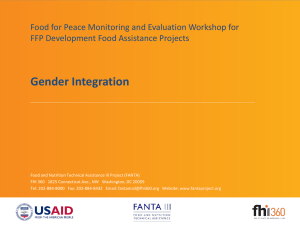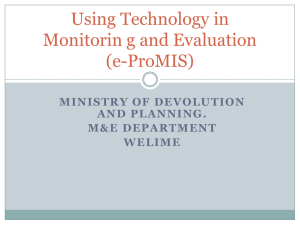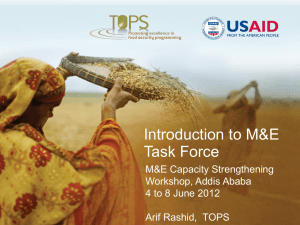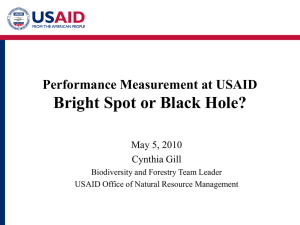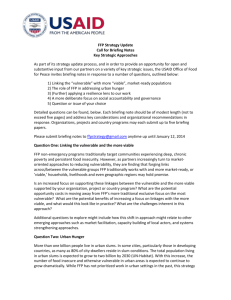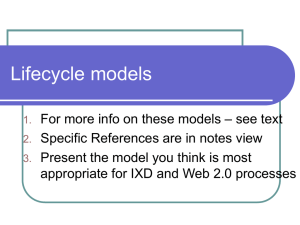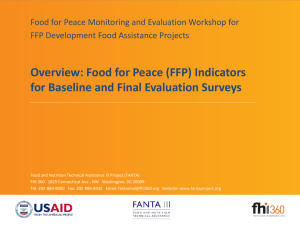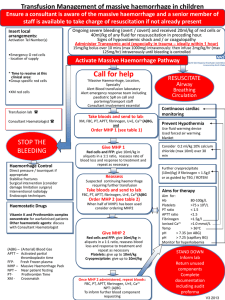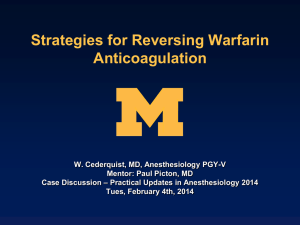Food for Peace Monitoring, Evaluation and Reporting Requirements
advertisement
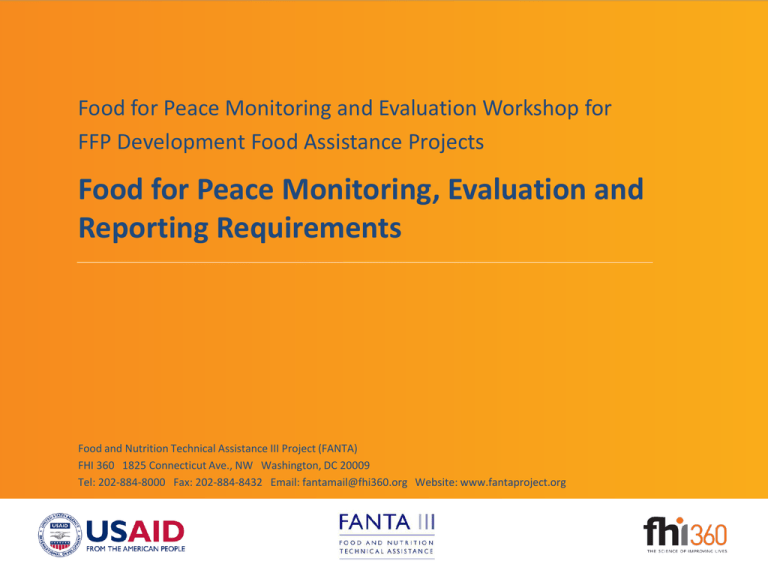
Food for Peace Monitoring and Evaluation Workshop for FFP Development Food Assistance Projects Food for Peace Monitoring, Evaluation and Reporting Requirements Food and Nutrition Technical Assistance III Project (FANTA) FHI 360 1825 Connecticut Ave., NW Washington, DC 20009 Tel: 202-884-8000 Fax: 202-884-8432 Email: fantamail@fhi360.org Website: www.fantaproject.org Session Objectives By the end of the session participants will have: 1. Shared their thoughts about the benefits of M&E 2. Reviewed the FFP M&E and Reporting Requirements and identified those that seem challenging to their projects Food for Peace Monitoring, Evaluation and Reporting Requirements Activity 1: Share your thoughts… Who will benefit from the results of your M&E work and how/why? Food for Peace Monitoring, Evaluation and Reporting Requirements Session Objective Session Objective Review FFP M&E and reporting requirements for the lifecycle of a project Project Lifecycle, M&E and Start Up Stage Reporting Requirements Requirements Midway Requirements Annual Requirements Project End Requirements Food for Peace Monitoring, Evaluation and Reporting Requirements Next Section Project Lifecycle, M&E and Reporting Requirements Start Up Stage Requirements Midway Requirements Annual Requirements Project End Requirements Food for Peace Monitoring, Evaluation and Reporting Requirements Project Lifecycle, M&E and Reporting Requirements Project Lifecycle: What are the M&E and Reporting Requirements at Each Stage? End of project End of Year 1 Proposal stage Start Up End of Year 4 End of Year 2 Midway End of Year 3 Learning Information from M&E system Food for Peace Monitoring, Evaluation and Reporting Requirements closed Project Lifecycle, M&E and Reporting Requirements Requirement 1: LogFrame Narrative Summary Indicators Data Sources Goal Project Purpose Sub-purpose Immediate Outcome Output Input Food for Peace Monitoring, Evaluation and Reporting Requirements Assumptions Project Lifecycle, M&E and Reporting Requirements Requirement 1: LogFrame • LogFrame is a matrix that summarizes the Theory of Change and shows what the project intends to do and how, what the key assumptions are, and how outputs and outcomes will be monitored and evaluated. • Levels of LogFrame: goal, purpose, sub-purpose, immediate outcomes, outputs, inputs • Goal, purpose, sub-purpose, and immediate outcomes should be stated as results (not activities). • All elements of the LogFrame should be measurable and context specific. Food for Peace Monitoring, Evaluation and Reporting Requirements Project Lifecycle, M&E and Reporting Requirements Requirement 2: M&E Plan • • • • • Theory of Change LogFrame Indicator Performance Tracking Table (IPTT) Performance Indicator Reference Sheets (PIRS) Plans on: annual monitoring, data analysis, management, safeguard, dissemination, use, quality assurance, evaluation • M&E staffing plan and structure Food for Peace Monitoring, Evaluation and Reporting Requirements Project Lifecycle, M&E and Reporting Requirements Requirement 2: M&E Plan (continued) IPTT should include: • Baseline/final evaluation and annual monitoring indicators • All applicable FFP “required” and “required if applicable” indicators • Mission/F indicators, gender and environmental indicators (linked to performance of project activities only) • Indicators related to all levels of the LogFrame • Levels of disaggregation and targets for all indicators Food for Peace Monitoring, Evaluation and Reporting Requirements Project Lifecycle, M&E and Reporting Requirements USAID Evaluation Policy issued in January 2011 • Aims to help USAID learn more systematically from its work and increases accountability • Calls for “large” and “pilot/innovative” projects (of any size) to undergo evaluations that are external • Projects designed based on a proven Theory of Change should undergo performance evaluations, whereas “pilot/innovative” projects should undergo impact evaluations (the latter only if feasible) Food for Peace Monitoring, Evaluation and Reporting Requirements Project Lifecycle, M&E and Reporting Requirements USAID Evaluation Policy (continued) • Most evaluations will be external (i.e. third-party contractor or grantee managed by USAID, not by the implementing partners) • Decision on whether impact or performance evaluation at discretion of operating unit (FFP) • Most FFP food security projects will likely undergo performance evaluations (not impact evaluations) for the time being Food for Peace Monitoring, Evaluation and Reporting Requirements Next Section Project Lifecycle, M&E and Reporting Requirements Start Up Stage Requirements Midway Requirements Annual Requirements Project End Requirements Food for Peace Monitoring, Evaluation and Reporting Requirements Start Up Stage Requirements Requirement 3: FFP M&E workshop PVOs should attend the FFP M&E workshop (held by FANTA) • Madagascar: November 4-13, 2014 • Burundi: November 17-25, 2014 • Malawi: December 8-17, 2014 Two days intro sessions followed by technical assistance one-on-one for each award Food for Peace Monitoring, Evaluation and Reporting Requirements Start Up Stage Requirements Requirement 4: ToC, Logframe, IPTT Submit revised LogFrame, IPTT, Theory of Change (ToC) due 20 days to FFP after the M&E workshop. • Target values for baseline/final evaluation indicators are submitted as percentage point change during proposal stage. No need to update these targets until after baseline survey conducted • BUT target values for annual monitoring indicators required with submission of revised IPTT 20 days after workshop Food for Peace Monitoring, Evaluation and Reporting Requirements Start Up Stage Requirements Start Up Stage: Requirement 5 Requirements #5: Submit comprehensive M&E Plan and Detailed Implementation Plan (DIP)—due 60 days after the M&E workshop to FFP Strongly encouraged: Attend new M&E Plan workshop held by TOPS in coordination with FFP. Food for Peace Monitoring, Evaluation and Reporting Requirements Start Up Stage Requirements Requirement 6: Baseline Study Third-party survey firm (not PVO) to conduct baseline study • Projects can start implementation before data collection for the baseline is complete! • Quantitative study must use population-based household survey (simple prepost designs required only) • Baseline survey must be comparable to the final evaluation survey • Data collected for impact and some outcome indicators from IPTT; includes FFP gender indicators Food for Peace Monitoring, Evaluation and Reporting Requirements Start Up Stage Requirements Baseline Study (continued) Third-party survey firm (not PVO) to conduct baseline study • Study will include a qualitative component to add richness and context to the quantitative results • Completed within first year of implementation as early as possible (and ideally during the “lean season”) • Baseline report will provide results by PVO and for the overall FFP program implementation areas • Datasets also required to be submitted to comply with USG Open Data requirements • PVO can conduct other formative research, as needed Food for Peace Monitoring, Evaluation and Reporting Requirements Next Section Project Lifecycle, M&E and Reporting Requirements Start Up Stage Requirements Midway Requirements Annual Requirements Project End Requirements Food for Peace Monitoring, Evaluation and Reporting Requirements Annual Requirements Requirement 7: Annual Results Report Submit annual results report (ARR)—retrospective reporting relative to US fiscal year (Oct 1–Sept 30) ARR Narrative Annual Results Report Attachments to FFPMIS FFPMIS Data Entry Food for Peace Monitoring, Evaluation and Reporting Requirements Annual Requirements Annual Results Report (continued) 1. ARR Narrative containing: • Annual Food Assistance Project Activities and Results • Lessons Learned Food for Peace Monitoring, Evaluation and Reporting Requirements Annual Requirements 2. Annual Results Report (continued) Attachments to FFPMIS: • Success Stories • Indicator Performance Tracking Table (IPTT) • IPTT Data Source Descriptions • Detailed Implementation Plan (DIP) • Expenditure Report • Technical Sectors Tracking Table • Program Design and Performance Reports • Supplemental Materials Food for Peace Monitoring, Evaluation and Reporting Requirements Annual Requirements Annual Results Report (continued) 3. FFPMIS Data Entry: • Monetization and Cost Recovery Tables • Standardized Annual Performance Questionnaire (SAPQ) • Beneficiary and Resource Tracking Tables Food for Peace Monitoring, Evaluation and Reporting Requirements Next Section Project Lifecycle, M&E and Reporting Requirements Start Up Stage Requirements Midway Requirements Annual Requirements Project End Requirements Food for Peace Monitoring, Evaluation and Reporting Requirements Midway Requirements Requirement 8 (PVO): Mid-term Evaluation • Reasons for conducting MTE: Learn from successes, acknowledge problems Assess implementation progress and roadblocks • • • • Participatory, qualitative assessments are encouraged Process evaluation Team leader must be external MTE team should comprise expertise in all technical sectors and cross-cutting issues addressed by project • No MTE team members should have previous responsibility in design/implementation of project under evaluation Food for Peace Monitoring, Evaluation and Reporting Requirements Midway Requirements Mid-term Evaluation (continued) • MTE finalized for FFP 5-year development projects by mid PY3 • Not required to include quantitative component or be populationbased like baseline/final evaluation • Midterm report to be submitted to FFP 3 months after data collection ends or qualitative study conducted Food for Peace Monitoring, Evaluation and Reporting Requirements Next Section Project Lifecycle, M&E and Reporting Requirements Start Up Stage Requirements Midway Requirements Annual Requirements Project End Requirements Food for Peace Monitoring, Evaluation and Reporting Requirements Project End Requirements Requirement 9: Final Evaluation Study Third-party survey firm to conduct final evaluation study (quantitative and qualitative) • Quantitative study must use population-based household survey (simple pre-post designs required only) • Final evaluation survey must be comparable to the baseline survey same impact and outcome indicators and questionnaires same time of year • Most will be performance evaluations with pre-post designs. Food for Peace Monitoring, Evaluation and Reporting Requirements Resources Resources FFP Request for Applications http://www.usaid.gov/what-wedo/agriculture-and-food-security/foodassistance/programs/development-programs FFP ARR Guidance http://www.usaid.gov/what-we-do/agricultureand-food-security/food-assistance/guidance/implementation-andreporting USAID Evaluation Policy http://www.usaid.gov/evaluation/ Food for Peace Monitoring, Evaluation and Reporting Requirements This presentation is made possible by the generous support of the American people through the support of the Office of Health, Infectious Diseases and Nutrition, Bureau for Global Health; and the Office of Food for Peace, Bureau for Democracy, Conflict and Humanitarian Assistance, United States Agency for International Development (USAID), under terms of Cooperative Agreement No. AID-OAA-A-12-00005, through FANTA, managed by FHI 360. The contents are the responsibility of FHI 360 and do not necessarily reflect the views of USAID or the United States Government. Food for Peace Monitoring, Evaluation and Reporting Requirements

